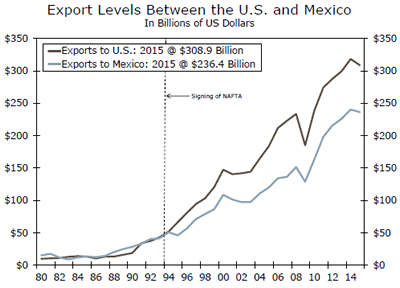U.S. Review
Data Supports Cautiously Optimistic Fed View
- The Federal Reserve held rates steady this week, as widely expected. It reiterated the strengthening U.S. domestic outlook would warrant gradual policy tightening over the medium term. No clues were given on the timing of the next move, likely because uncertainty surrounds the unfolding of the new administration’s policy, and the Fed can afford to wait for clarity because inflation remains tame.
- The economic calendar was packed with more positive reads on the U.S. economy, capped off with the 227,000 jobs added in January – a fairly solid start to what is shaping up to be an interesting year.
No Urgency in Data, Fed Has Space to See Policy Unfold
FOMC members see a strengthening U.S. economy that warrants a gradual return to normal monetary policy. The trick now is timing interest rate moves without derailing said strength. After checking the box on the full employment objective, guiding inflation to 2 percent requires a bit more finesse. Tight labor markets fuel inflation and monetary policy tools operate on a lag; therefore, the data-dependent Fed follows data-heavy weeks, like this one, closely for hints that inflation is moving ahead of target. Major indicators out this week – January jobs data, ISM surveys, consumer confidence and income & spending, to name a few – gave an upbeat assessment of the current economy and expected conditions going forward. Inflation indicators showed mild price pressure – enough to assure the Fed that inflation is firming but not flaring. Lack of urgency in the economic data thus far affords the FOMC some time to wait for clarity on the new administration’s policy actions and their economic implications.
Personal income and spending in December was solid, up 0.3 percent and 0.5 percent, respectively. Following two months of soft readings, personal consumption expenditures ended the year on better footing. Real personal spending was up a more muted 0.3 percent in December, as inflation cut into purchasing power. Still, Americans spent a larger share of income, lowering the savings rate to 5.4 percent from 5.6 percent in November – providing some hard data to corroborate optimism in the various consumer sentiment surveys since the election. Conference Board Consumer Confidence’s measure of expectations surged postelection but retraced in January, though consumers’ assessment of the present economic situation improved. Like the FOMC, consumers’ confidence in sustaining a strong economic outlook hinges on how the new administration’s policy unfolds.
Sentiment among manufacturers continues to improve, according to the ISM survey. The closely-watched indicator rose for the fifth consecutive month, to 56.0 in January, as broad-based gains across indices pointed to steady optimism among respondents. The employment component stood out most in the upbeat report, rising 3.3 points to 56.1. Pressure from soft global growth and the energy-related investment downturn has largely faded, though manufacturers still have to face headwinds from the stronger greenback weighing on exports. Inflationary pressures were also apparent in the report, with the prices paid component rising in 15 manufacturing industries, while none reported paying lower prices for inputs. This also assures the Fed inflation is on course to meet its target, as core goods deflation has weighed on overall inflation in recent years.
January’s jobs report surprised to the upside as employers added 227,000 jobs on the month, much stronger than the consensus estimate. The job market also pulled more Americans in from the sidelines; as the labor force participation rate rose 0.2 percentage points to 62.9 percent, giving the slight uptick in unemployment to 4.8 percent some positive light. Average hourly wage growth was softer than expected, particularly if the labor market is at full employment; this bears watching for the next few months. We still expect inflation to move to the two percent target this year, prompting two rate hikes, with the first move in June.

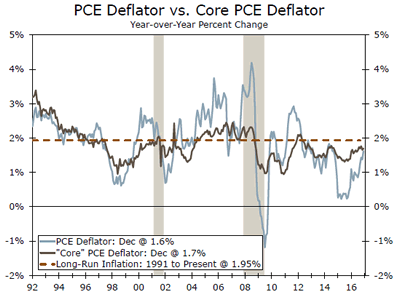

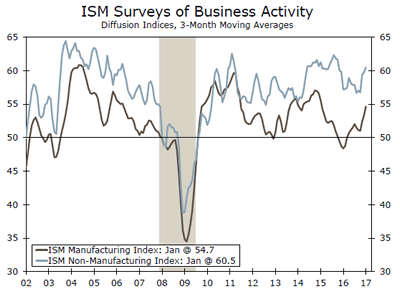
U.S. Outlook
Trade Balance • Tuesday
The international trade balance for the final month of 2016 likely remained more or less steady relative to the November trade deficit. Net exports exerted a sizable 1.7 percentage point drag on real GDP growth in Q4 as a whole, largely as a result of some payback due to the quirky surge in soybean exports that boosted growth in Q3. Despite quarterly volatility, net exports subtracted just 0.1 percentage points from real GDP growth in full-year 2016. Smoothing through the volatility, export growth has begun to stabilize after weakening early in 2016.
Should the data come in as expected, the full-year 2016 U.S. trade deficit would be approximately $500 billion. Despite the recent pickup in export growth, we expect the real trade deficit to widen a bit in 2017 as the dollar appreciates further, global growth remains tepid and healthy domestic demand continues to pull in imports.
Previous: -$45.2B Wells Fargo: -$44.6B Consensus: -$45.0B
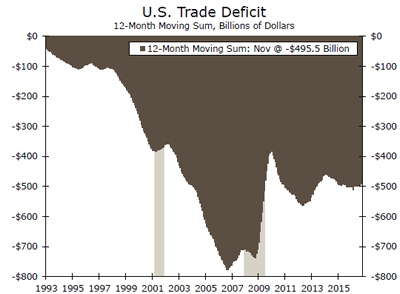
Import Price Index • Friday
Import prices increased 0.4 percent in December, boosted by a 7.9 percent surge in imported petroleum prices following OPEC’s agreement early in the month. However, dollar strength has continued to keep non-energy import prices under pressure; exfuels, import prices have fallen in three consecutive months and have not increased since last July.
We expect import prices to rise another 0.4 percent in January. If realized, this would bring the year-ago change to 3.5 percent, nearly double December’s multiyear high and the fastest pace of total import inflation since March 2012. Base effects from the steep decline in oil prices are providing a boost to import price inflation. Despite the dollar recently giving back some of its post-election gains, renewed dollar strength as the Fed moves forward with normalization will likely counteract some of the inflationary effects of higher energy prices in this space.
Previous: 0.4% Wells Fargo: 0.4% Consensus: 0.4% (Month-over-Month)
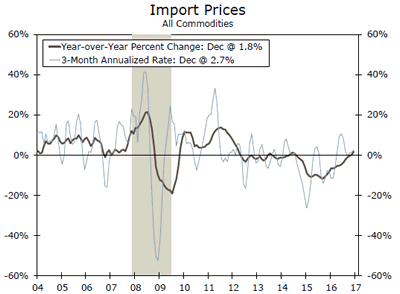
Monthly Budget Statement • Friday
The fiscal stimulus debates sparked by the election have brought federal revenue and spending trends to the forefront for markets. The Monthly Treasury Statement offers a snapshot of these trends. For most of the recovery, revenue growth outpaced spending growth as the result of an improving economy and policy changes. More recent, however, spending growth has returned to a steady pace, while revenues have decelerated dramatically.
Multiple factors have led to the anemic pace of tax collections, including weak corporate profits, slowing employment growth and smaller capital gains realizations. On balance, our expectation for faster economic growth in 2017 should fuel higher tax collections, but a robust turnaround seems unlikely at this point in the cycle. As policymakers weigh changes to the tax code, the recent federal revenue slowdown will do them few favors as they strive to maintain deficit-neutrality.
Previous: -$27.5B Consensus: $33.0B

Global Review
Global Economy Getting on Firmer Footing
- Real GDP in the Eurozone grew at an annualized rate of 2.0 percent in Q4, stronger than most analysts had expected. In the United Kingdom, the Bank of England revised up its forecasted growth rate to 2.0 percent from 1.4 percent for 2017, but does not seem to be in a great hurry to tighten rates.
- Real GDP in Canada rose more than expected in November, although it is difficult to make a convincing case that the Canadian economy is "booming" at present. Real GDP in Mexico rose 2.2 percent on a year-ago basis in Q4. We remain concerned about the outlook for the Mexican economy going forward.
Global Economy Getting on Firmer Footing
Real GDP data released this week showed that economic growth in some of America’s major trading partners was reasonably solid in Q4-2016. If, as we expect, economic growth in the rest of the world firms further in coming quarters, then the outlook for U.S. exports should brighten somewhat, everything else equal.
Real GDP in the Eurozone grew at an annualized rate of 2.0 percent in the fourth quarter, a tad stronger than the 1.8 percent growth rate that was registered in Q3 (see chart on front page). A breakdown of the GDP data into its underlying demand components will not be available for another month, but it appears that growth in Q4 was driven primarily by domestic demand. If so, then the expansion in the Eurozone is becoming more and more self-sustaining. Although the ECB is probably not quite ready to dial back its QE program, it could begin to do so later this year. (See Is ECB Policy Tightening Coming Into View, which is posted on our website.)
We reported in this space last week that real GDP in the United Kingdom grew at an annualized rate of 2.4 percent in Q4 (top chart), which was stronger than the rate that most analysts had expected. This week, the Bank of England released its quarterly Inflation Report in which it revised its own GDP forecast for 2017 up to 2.0 percent from 1.4 percent. Interestingly though, the Monetary Policy Committee (MPC) does not seem to be in a huge hurry to raise rates. Not only did all nine MPC members vote at the Feb. 2 meeting to keep policy on hold, but the MPC indicated in the statement after the meeting that it could tolerate a temporary overshoot of CPI inflation above its 2 percent target. (See U.K. Q4 GDP Growth: BoE Policy Implication for our most recent thoughts on British interest rates going forward.)
Moving on to North America, real GDP in Canada rose 0.4 percent in November relative to the previous month (middle chart). Not only was the outturn stronger than most analysts had expected, but it more than reversed the 0.2 percent decline in output that occurred in October. It appears that the Canadian economy has accelerated again following the marked slowdown that accompanied the collapse in energy prices that commenced in 2014. That said, it is difficult to make a convincing case that the Canadian economy is "booming" at present with a year-over-year growth rate of only 1.7 percent. Consequently, we look for the Bank of Canada to remain on hold throughout most of 2017.
South of the border, real GDP in Mexico rose 2.2 percent on a year-ago basis in Q4, a slight uptick from the 2.0 percent rate that was registered in Q3 (bottom chart). As we wrote earlier this week, however, growth in the Mexican manufacturing sector remains lackluster. (See Mexican Economic Growth Slows a Bit in Q4-2016.) Moreover, we remain concerned about the outlook for the Mexican economy going forward. As we noted last week, the central bank has hiked rates by 275 bps since December 2015 in an effort to counter some of the sharp downward pressure on the currency. Indeed, we forecast that the combination of rising interest rates and uncertainty related to NAFTA will lead to a mild recession in the Mexican economy this year.
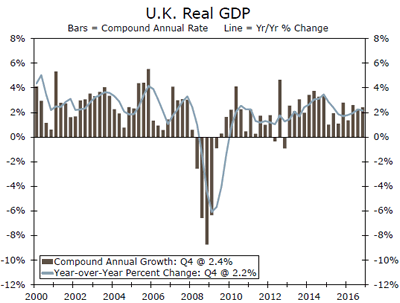
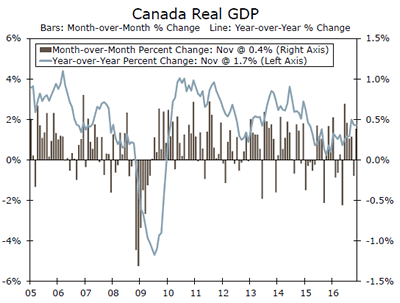
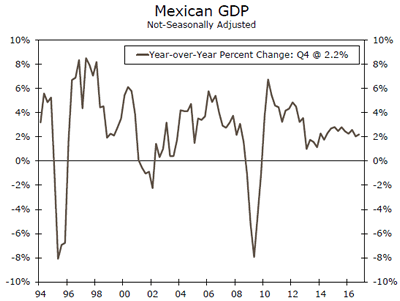
Global Outlook
U.K. Industrial Production • Friday
British industrial production (IP) grew by a stronger-than-expected 2.1 percent on the month in November. Oil and gas production surged as the Buzzard oil fields came back on line after an extended shutdown – one of the U.K.’s largest oil fields. Year over year, overall IP was up 2.0 percent, compared to the 0.9 percent decline in October. In addition, manufacturing production saw a 1.3 percent increase on the month helped by a large upswing in the pharmaceutical sector. On a year-ago basis, the manufacturing sector grew by 1.2 percent. For December, the consensus expects slower growth for industrial and manufacturing production as warmer weather more than likely hampered output in the energy sector.
Meanwhile, next week we will also get data on the U.K.’s December’s trade balance, which widened in November as the increase in exports was not enough to offset the jump in imports.
Previous: 2.0% Consensus: 2.9% (Year-over-Year)

Mexico Industrial Production • Friday
Mexican industrial production (IP) was unchanged in November from a month prior as a slump in mining nearly offset strong gains in manufacturing production. However, the year-over-year results showed an improvement of 1.3 percent, compared to the 1.2 percent decline in October. Preliminary fourth-quarter economic data showed that the industrial sector posted a flat rate, underscoring the difficult times the sector is facing, even as the Trump administration has not started the process of attempting to renegotiate NAFTA. The manufacturing sector, which grew 4.3 percent in November 2016 compared to the previous year, could be negatively impacted depending on the outcome of the negotiations.
Other data slated for release next week include consumer price inflation and vehicle production.
Previous: 1.3%
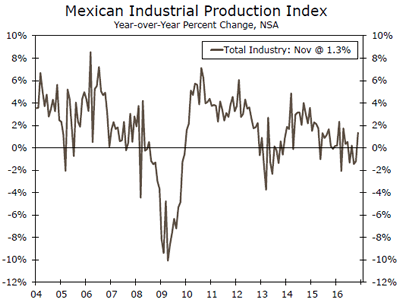
Canada Jobs Report • Friday
Canada’s jobs report is quite volatile month to month as shown in the graph on the right. In December, Canada employment bested expectations of a slight loss of jobs, adding 53,700 jobs, and ended the year up 214,000 jobs – the largest increase since 2012. December’s report came on the tails of a 10,700 increase in November and marked five months of consecutive growth. That said, the economy actually added 81,000 full-time positions in December, offset by a loss of 27,000 part-time positions. By sector, jobs were added in both the service-producing (+52,000) and goods-producing sector (+1,700), which includes manufacturing. Meanwhile, Canada’s unemployment rate ticked up to 6.9 percent, as more people entered into the workforce. Markets do not expect for this momentum to have carried into the new year and looks for the economy to have shed 10,000 jobs in January.
Previous: 53,700 Consensus: -10,000
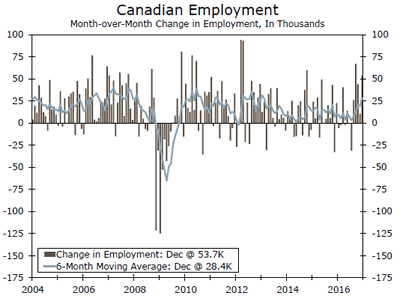
Point of View
Interest Rate Watch
Anticipating Fed Expectations
"Inflation increased in recent quarters but is still below the Committee’s 2 percent longer-run objective." – FOMC statement from the February meeting.
But not for long – our forecast for the PCE deflator calls for 1.9 percent in the current quarter and then 2.0 percent by Q3. This would signal a continued negative real fed funds rate (top graph). The rise in inflation is consistent with stabilizing oil prices that should no longer prevent inflation from hitting the 2 percent target by mid-2017. Meanwhile, on the labor market side of the mandate, the unemployment rate has fallen from 6.2 percent in 2014 to 4.8 percent currently. We expect two moves in 2017 – the first in June and a second dependent on the market and FOMC’s perception of the impact of the administration’s economic initiatives.
Market Moving Ahead of FOMC
In contrast to the FOMC’s characterization of inflation expectations, the Fed’s five-year five year forward measure of inflation expectations has shifted upward noticeably post-election. This is reflected in the market’s reaction as illustrated in the middle figure. However, if the FOMC’s neutral fed funds rate is indeed 3.0 percent, as they estimate, this would suggest the two-year Treasury yield has a long way to go – upward.
Global Economic Improvement and the Fed’s Balance Sheet
Our outlook is for an improvement in global growth in 2017 relative to 2016 with increased reflation in several U.S. trading partners. Global and U.S. reflation will put pressure on the FOMC to begin a rebalancing of its balance sheet (bottom graph) which we believe would be possible by mid-2018. Fed guidance is imprecise as phasing-out reinvestment is timed to occur "once normalization of the fed funds rate is well under way." Of course, this imprecision is to be expected, given the uncertainties of economic and political developments over the next two years. Normalization would likely feed into the fiscal policy debate as the interest rate burden of the federal debt would increase with a balance sheet reduction.

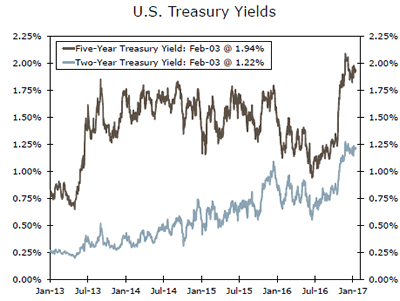
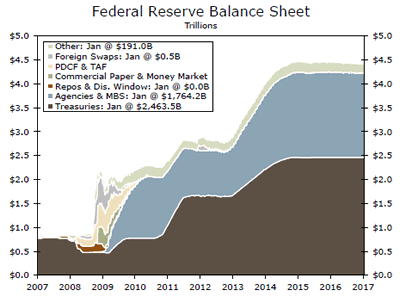
Credit Market Insights
The Return of Homeowner Equity
U.S. home prices have rebounded meaningfully since the Great Recession. According to data from S&P CoreLogic Case-Shiller, national home prices have risen nearly 40 percent from their 2012 trough. While the persistent increase in home prices has created affordability challenges in many markets around the country, homeowners have largely benefitted from rising home values.
Fueled by home price appreciation and the pay down of principal, homeowner equity – the difference between the value of one’s home and the amount of mortgage debt on the home – has climbed higher. After hitting a trough in Q2 2011, home equity wealth has risen by more than 50 percent, increasing from $6.1 trillion to $13.0 trillion in Q3 2016. Negative homeowner equity – those that owe more on their home than it is worth – has also shown cyclical improvement. Just 6.3 percent of homeowners with a mortgage have negative equity, which is down from 26 percent in 2010, according to CoreLogic estimates.
The rise in home equity wealth corresponds with other barometers of consumer finances, including delinquency rates and income growth, which point to strengthening household balance sheets. Moreover, the rebuilding of this component of household wealth has been supportive for consumer spending. We expect national home prices to rise another 4 percent in 2017, supporting additional gains in equity.
Topic of the Week
NAFTA Rules of Origin: What Is at Stake?
At a time when supply chains extend across country boundaries all over the world, NAFTA’s rules of origin become even more important to determine the source of exported and imported goods. The rules of origin are used to determine if products produced in a member country of NAFTA, using imported inputs, are considered to have been produced in that country for taxing purposes. That is, it determines if the product has enough NAFTA country content to not pay duties or taxes imposed on imports. For example, an automobile produced in North America is considered exempt of duties if 62.5 percent of the automobile originates in North America. The Trump administration could negotiate an increase of that percentage to encourage greater production of automobiles in the United States versus automobiles produced in Europe or Asia.
This is important, because, in the past, companies have tried to bypass free trade agreement rules by originating production in member countries of NAFTA by locating a single part of the production process in the United States, Canada or Mexico. However, this part of the production process is so minimal it is clear that the firms organized such production to benefit from the lower taxes. An example that comes to mind is a producer of orange concentrate from outside the NAFTA region that opens a plant in one of the NAFTA member countries just to add water to the concentrate and sell it as orange juice produced in NAFTA, thus avoiding taxes on trade.
Rules of origin exist for all production taking place in the United States, Canada and Mexico and determine if a product is indeed produced by one of the members of the trade agreement for purposes of taxes/duties. Changing the rules of origin could benefit U.S. producers and generate more jobs in certain industries, like the automobile industry, something that could address the issues brought about by the Trump administration.

